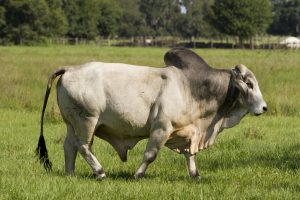As the cost of cattle rises, it is becoming increasingly important to select the best bull for your herd. Bulls contribute 50% of the genetics for a calf crop, selecting a high-quality bull will help his genetics spread through your herd faster making it a necessary investment. A bull must meet the needs of the herd and the producer. When selecting one, it is important to consider numerous factors. Genotype factors relate to the bull’s genetics while phenotype factors are observable characteristics of how the bull should look that you compare to the ideal animal.
Genotype Factors
- Performance Records/Pedigree
- Information is gathered by examining his pedigree (dam & sire).
- Expected Progeny Differences (EPD)
- EPDs offer a prediction of the genetic transmitting ability of a parent to its offspring.
- Bulls can be selected for specific growth and carcass traits, such as yearling weight, marbling, and birth weight.
- Producers can use this data to meet their production goals through genetic improvement.
Phenotype Factors:
- Structural Correctness: It is important for a bull to be structurally sound for its overall health and ability to breed. It includes the following characteristics:
- Slope of shoulder
- Set of knee
- Levelness of hip
- Correct set of hock
- A functional bull is deep and big-bodied, easy fleshing, correct angle to joints, correct foot size and heel structure, and moderate in size
 Evaluating Muscle: Muscle is an important factor in a bull’s makeup and is an indication of meat production. You want your bull to stand wide at the ground and have muscle shape out of his forearm, topline, and hip. Locations to evaluate muscle include:
Evaluating Muscle: Muscle is an important factor in a bull’s makeup and is an indication of meat production. You want your bull to stand wide at the ground and have muscle shape out of his forearm, topline, and hip. Locations to evaluate muscle include:
- Side: forearm, topline, and rear quarter
- Behind: Evaluate muscle on how wide he is in his pin set and look how wide he stands at the ground.
- Sheath Score: A bull’s sheath can impact their ability to breed. Having a relatively high and tight sheath is ideal for breeding purposes. A looser, lower sheath can prevent the bull from breeding cows naturally and are more prone to injury.

Other factors to consider when preparing for the breeding season:
- Yearly Breeding Soundness Exam (BSE): A BSE is a physical exam of both internal and external reproductive organs and is performed by a veterinarian. It includes a semen collection and measuring of the scrotal circumference. In order to pass a BSE, the bull must:
- Have at least 70% normal sperm
- Pass a physical exam
- Meet the minimum requirement for scrotal circumference
- Have at least 30% sperm motility
- Body Condition Scoring (BCS): Bulls should be evaluated 60 days before the breeding season, with an ideal BCS of 6. https://edis.ifas.ufl.edu/publication/AN347
- Bull Health: Producers should maintain a relationship with their veterinarian to maintain the health of their herd. Try to vaccinate your bulls 30 days before breeding season.
- Bull to Cow Ratio: Multiple factors can influence the bull to cow ratio of your bull. These factors include breed and the bull’s age. It is important to know what your bull’s bull to cow ratio is to ensure that your entire herd can be serviced.

References:
Thomas, M. & Hersom, M. 2021. Considerations for Selecting a Bull. UF/IFAS EDIS document. https://edis.ifas.ufl.edu/publication/AN218
 0
0
 Evaluating Muscle: Muscle is an important factor in a bull’s makeup and is an indication of meat production. You want your bull to stand wide at the ground and have muscle shape out of his forearm, topline, and hip. Locations to evaluate muscle include:
Evaluating Muscle: Muscle is an important factor in a bull’s makeup and is an indication of meat production. You want your bull to stand wide at the ground and have muscle shape out of his forearm, topline, and hip. Locations to evaluate muscle include:
